Concerned that your well water level is getting low? Or just curious to know how much water you have? In this guide, we’ve shared our top tips on how to check the water level of your well.
📌 Key Takeaways
- Knowing your well water level is useful if you plan to install a new well pump or want to avoid over-using the water in your well.
- The easiest way to check your well water level is with a visual inspection.
- If this isn’t possible, you can measure water depth by dropping a rock, using a water bottle and a fishing line, using a tape measure with a weight, or investing in a professional well depth measuring device.
- Well depth, well water level, and well water quality are three separate measurements.
6 Top Ways to Measure Well Static Water Level
- Visual Inspection
- Drop a Rock & Measure Fall Time
- Tape Measure & Weight
- String & Weight
- Fishing Line & Water Bottle
- Professional Well Measuring Device
Table of Contents
📏 Why Measure Your Well Water Level?
There are several reasons why you might need to make well water depth measurements.
Perhaps you’re planning to install a new well pump. To accurately size a submersible pump, you need to know your well’s static water level – the distance from the surface of the ground to the surface of the water in the well.
Or maybe you’re experiencing a drought in your area and you want to make sure you have enough water in your well to see you through. By knowing your static water level, you can appropriately limit your daily water use to prevent your well from drying out before the next rainfall.
Perhaps you’re simply curious to see how much water your well contains. Wells do sometimes dry out, especially if they’re not monitored and managed effectively. Knowing how much water your well contains means you can prepare – either by reducing your water use or putting some money aside to get your well drilled further below the ground.
Finally, taking well water depth measurements will give you an idea of the volume of water in your well, which is pretty essential information if you plan to shock your well. You need to add enough chlorine to effectively disinfect your drinking water without overwhelming your resources. By checking your well’s depth, you’ll be able to correctly measure the chlorine used.
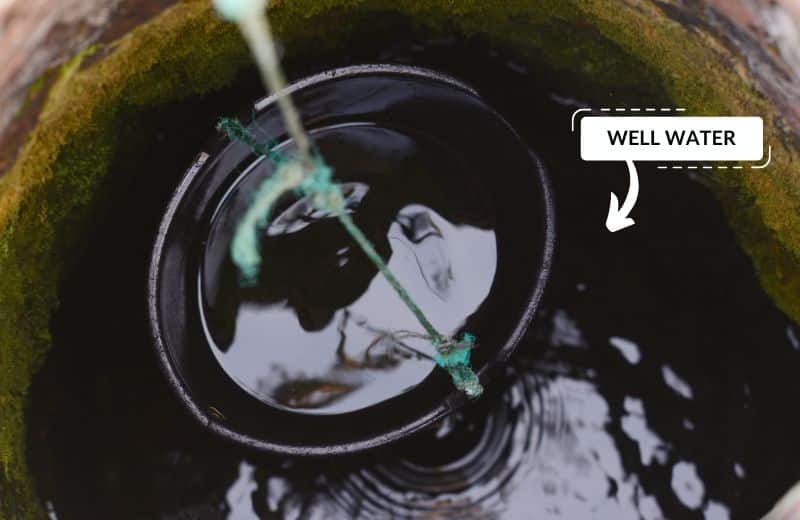
📉 How To Measure the Depth of Your Water Well
Luckily, measuring your well’s static water level is easy and inexpensive, using materials you probably already have at home.
1) Quickest & Cheapest Option: Visual Inspection
Looking for a quick, easy way to check the water level in your well? Simply open the well cap and look down the well casing.
📌 Make sure your well is fully recovered before you conduct a visual inspection. This means that you’ve avoided drawing from the water table for long enough for the well water levels to be back to full capacity. The maximum recovery rate for a well in good condition is 12 hours.
If you can see water, that’s a good sign. You should be able to see the reflection from water up to 50 feet below the surface of the ground.
Shine a flashlight into your well to give you a better view of the static water level.
A visual inspection probably won’t work if your well is very deep. If it falls into the deep well category, skip the visual inspection and try one of the next options.
2) Also Quick and Easy: Drop a Rock and Measure Fall Time
Another well water measurement technique that requires no real skill and no additional equipment is the rock drop technique.
Pick up a small pebble or rock from your yard. Prepare a stopwatch (such as the one on your phone) and hit “start” at the same moment that you release the rock over the well shaft.
Keep the timer on until you hear the splash of the rock in the water. Stop the timer straight away.
You should now have a time in seconds that it took for the pebble to hit the water. Multiply this number by 24, which gives you a rough estimate of your well depth in feet.
Don’t expect this measurement to be bang-on-accurate. Give or take 10 feet or so. Still, it’s a good way to estimate your static water level.
📌 It’s best not to repeat this method frequently to avoid a collection of pebbles in your well. Plus, if your well uses a submersible pump, don’t use this method. You might end up getting the rock caught between the well casing and the pump, affecting the pump’s functioning and potentially leading to expensive damage.
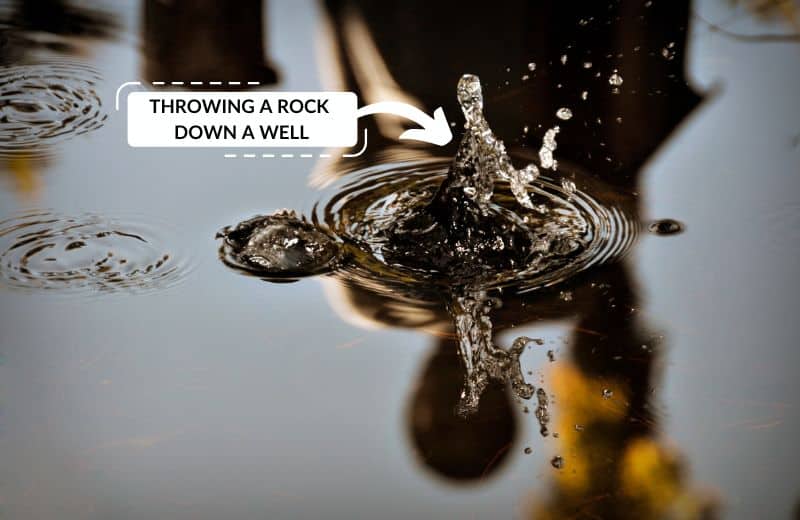
3) Slightly More Accurate: Use a Tape Measure And a Weight
Let’s go one step up from the rock-tossing method. If you have a tape measure and any sort of weight (like a small fishing weight or a nut or bolt), try the tape measure and weight technique.
Attach the weight to the bottom of the tape measure. You might need to cut a hole in the tape measure to tie the weight with string.
Lower the tape measure into the well, and listen out for the sound of the weight hitting the water. You should also be able to feel when the weight lands.
Once the weight has landed, check the number on your tape measure. That will tell you your total well water depth.
4) Better For Deep Wells: Use a String And a Weight
To get the most accurate depth-to-water measurement of a deep well, swap the tape measuring tool for a long piece of string.
Tie a weight or fishing float to one end of the string. Lower the string into the well until you hear and feel the weight landing in the water.
You might need to make your string longer if you underestimated your well depth. Just tie the new piece of string onto the string you’ve lowered into the well.
Once the weight hits the bottom, mark and cut the string just above your hand. Then carefully bring the string back up, remove the weight, and lay the string next to a measuring tape to get your well’s total depth.
You might have to use several tape measures to measure the string, depending on the depth of your well.
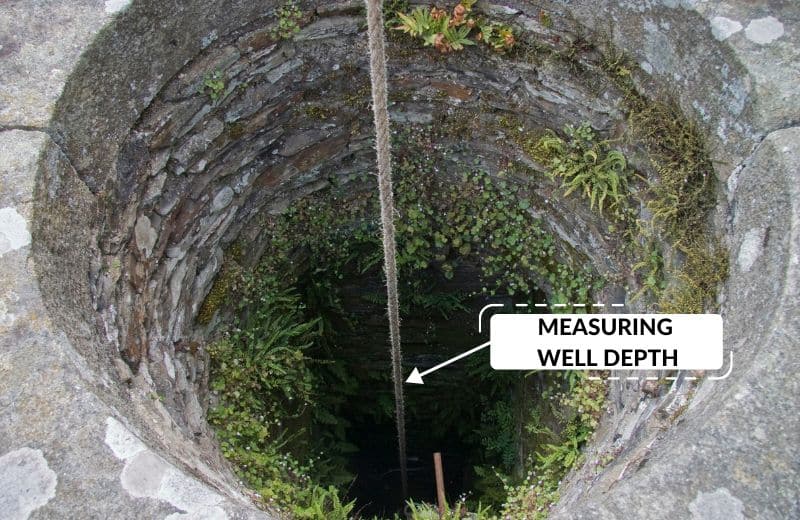
5) Alternative Method: Fishing Line and Water Bottle
Don’t have weights or a long enough piece of string? You can still conduct a well measurement test with a water bottle and some fishing line.
Fill the water bottle half-full of water. Tie a piece of fishing line to the rim around the water bottle lid. Make sure the line is tied tightly and won’t come loose.
Let the fishing line go slack, then drop the water bottle into the well. Once you can’t feel the weight of the bottle at the end of the line, you know the bottle has hit the water.
Pull the line up as tight as possible while keeping the water bottle on the surface of the water. Mark the fishing line, then pull the line back up. Use a measuring tape to measure from the marked section of the fishing line to the water bottle.
6) Most Accurate Method: Professional Well Measuring Device
The most accurate way to measure your well’s status water level is with a professional well measuring device.
📌 These devices are usually expensive ($500 upwards) and come in lengths from 100 feet to more than 1,000 feet. Your local well drilling company will probably have a well measuring device, but for the average homeowner, the tool isn’t usually worth the cost.
A well measuring device has a piece of measuring tape with a metal probe attached to the end. The device is lowered into the well by an electric motor. As it lowers, it emits a current, and alerts the user by beeping loudly when the tape starts dropping below water level.
The user can then read the static water level on the measuring tape.
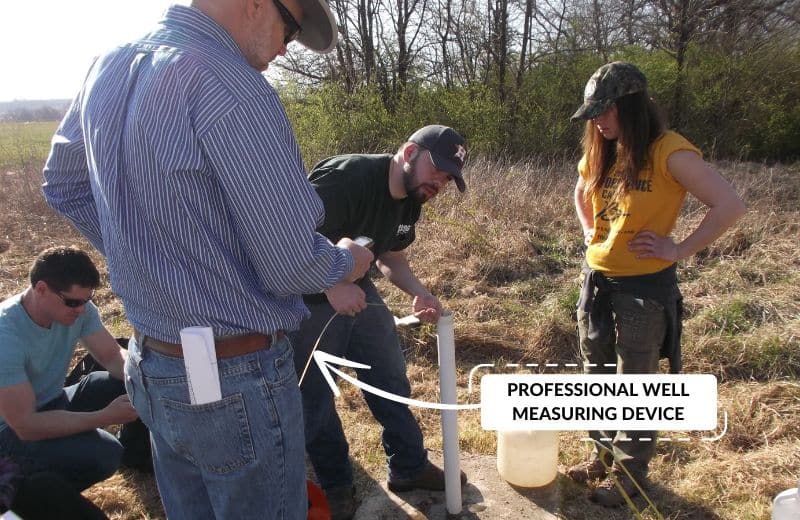
📥 What do Well Depth Measurements Mean?
Your total well depth and static water level are slightly different measurements. Here, we’ve offered summaries of the different types of well depth measurements you may come across.
- Well depth: The distance from the bottom of the well to the surface of the ground.
- Water level: The height of water in a fully-recovered well.
- Water quantity: The amount of volume in a fully-recovered well
- Well flow rate: The amount of water that is drawn out of the well, typically measured in gallons per minute (GPM).
- Drawdown depth: The lowering depth of the pump beneath the water level while the pump is running.
📝 How to Match Well Pump Capacity to Well Depth
Now you (hopefully) know your static water level, you might be wondering how to use this information to correctly size a new pump for your well.
To do this, take your well depth and subtract five from this figure. Then, make sure the maximum rated depth of your well pump doesn’t exceed this number.
Why subtract five feet from your total static water level? Because this will keep the pump raised high enough to prevent it from drawing in sand, silt, and debris, which will clog your well components and your plumbing system.
If you’re unsure about how to correctly size a well pump, your pump supplier or contractor should be happy to help you to determine the correct pumping water level.
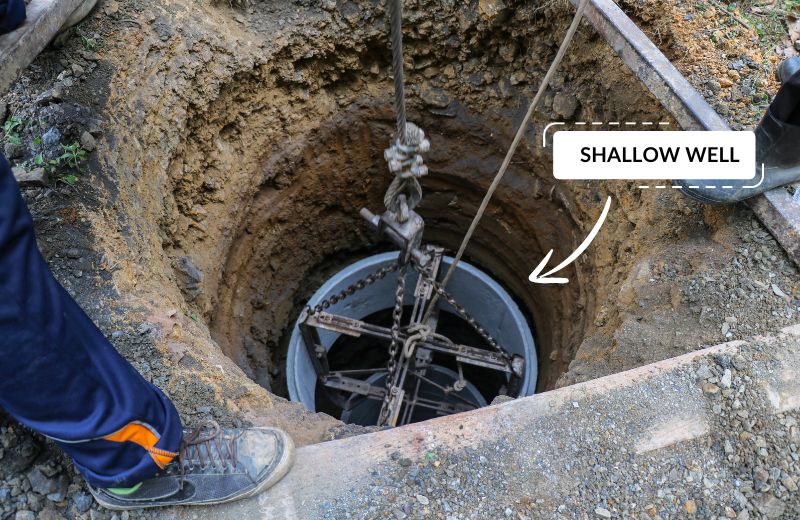
❔ How to Check Well Water Depth: FAQ
How do I find out how much water is in my well?
You can find out how much water is in your well by looking down the well casing or by throwing a stone and counting the seconds it takes to land. For a more accurate reading of your well water depth, you can use a professional well depth measurement tool.
How do you know if your well water is low?
You know your well water is low if your faucets begin sputtering, your drinking water becomes muddy or murky, your pump runs longer than usual, your water pressure decreases, or it takes a long time for your well water level to recover after a period of heavy use. Some of these observations can also be signs of a failing well pump, so get your well inspected by a professional if you’re unsure.
How do I monitor my well level?
You can monitor your well level by routinely measuring your well water depth and making notes of your measurements in a log book. Try to get into the habit of measuring your water depth at least once a month. Compare your measurements and look out for trends in decreasing water levels.
What is the standard depth of a well?
The standard depth of a well is 100 to 800 feet. The standard volume of water for a well is 1.5 gallons per foot of casing. Your well water volume depends on numerous factors, including your well depth, your well size, your local groundwater use, and your water table fluctuations.
What is a good well depth?
A good well depth is at least 100 feet deep. A well at this depth should be protected from surface water contaminants because of the ground filtration that removes impurities from water seeping through the earth.
How do you know if your well is deep enough?
You know your well is deep enough if you have an adequate water supply and you don’t have to limit your water use throughout the year. You may need to hire a contractor to drill deeper into the ground if your well is starting to dry up.
What is the best instrument to measure the depth of a well?
The best instrument to measure well water depth is a professional well depth measuring tool. This tool will give you the most accurate reading of your well water depth from ground level down. You can also lower a tape measure directly into your well casing

I actually have a question. What is used to determine if a well is considered shallow or deep? The static water level or the depth of the water once the static level is reached? We want to get a hand pump for our well for SHTF times–especially since we live in Florida–and I don’t know what type to get.
Great question! The classification is typically based on the total depth, including both the static water level and the depth of the well once the static water level is reached